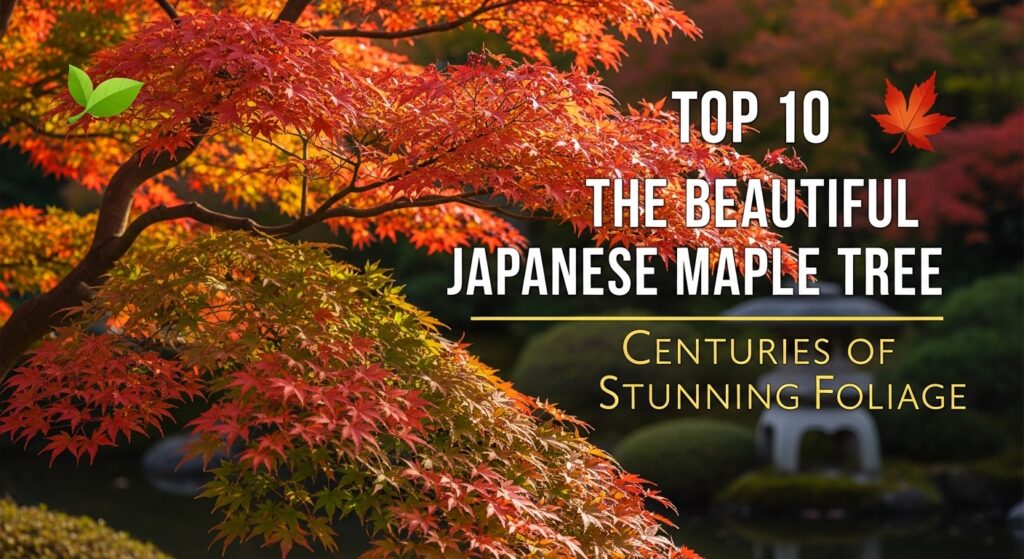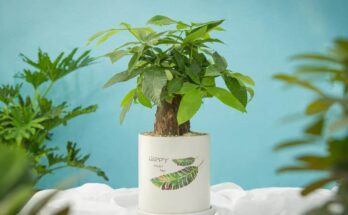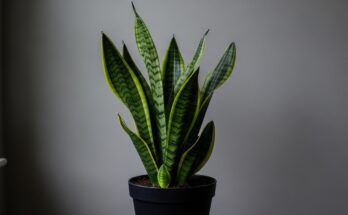
10 is this beautiful Japanese maple tree. These trees have been cultivated for their beautiful foliage for centuries in Japan. But luckily for us, they grow really well in zones 6 through 8. So if you live in that zone, then you can enjoy the beautiful red hues of this tree throughout the fall season. If you live outside of those zones, then don’t worry because we have plenty of other options for you later in this video. But coming in at Number. 9 is the giant white oak. The giant white oak is one of the most beautiful shade trees you will ever come across. It grows quickly, it has beautiful lobed leaves and it even provides delicious edible acorns for wildlife and humans alike. And since it grows well in zones 3 through 9, you can enjoy this beauty for hundreds of years. This tree is native to the United States and can grow to be over 100 feet tall with a 100-foot spread. So if you have the space for it, then you should definitely consider planting a giant white oak.
Our next tree is going to be the silver maple. Now this tree does have a smaller mature size than our last two trees, but it still has an incredible growth rate and gorgeous fall color. One thing that makes the silver maple unique is its deeply lobed leaves, which are similar to that of a sugar maple. But unlike the sugar maple, the silver maple tends to grow much faster and reaches a mature size of only 25 to 35 feet tall. And if you have a small yard, then you may want to consider the dwarf cultivar which only reaches a maximum height of 15 feet. This tree is hardy in zones 4 through 9 and would make an excellent addition to any yard.
Moving on, we have the American hornbeam, also known as the musclewood tree. This tree is prized by landscapers for its smooth gray bark and its beautiful fall color. The American hornbeam is very versatile when it comes to growing conditions and can adapt to a variety of soil types and moisture levels. It is also resistant to pests and diseases, making it a great choice for gardeners who are looking for a low maintenance tree. The American hornbeam typically grows in zones 4 through 9 and has a mature size of about 30 to 40 feet tall with a spread of 25 to 35 feet.
Next up, we have the ginkgo biloba. This tree is truly a sight to behold with its vibrant fan-shaped leaves. In the fall, the leaves turn a brilliant gold color and create a stunning display as they flutter to the ground. The gingko tree is also one of the oldest tree species on earth with fossils dating back over 200 million years. It is known for its resilience and ability to withstand harsh conditions, including pollution and drought. Despite its tough exterior, the gingko tree is also very delicate and requires special care during planting and pruning. If you can provide the necessary attention and care, then the Ginkgo Biloba will reward you with its stunning beauty for many years to come. And luckily for us, these trees are considered to be one of the easiest trees to grow and they grow well in zones 3 through 9.
Up next, we have the crabapple tree. Crabapple trees are small flowering trees that are prized for their beautiful blooms and edible fruit. They typically grow between 15 and 25 feet tall and produce flowers in shades of pink, white or red depending on the cultivar you choose. The flowers are highly attractive to pollinators like bees and butterflies and the tree itself is resistant to pests and diseases. Once the flowers fade, they are replaced by small round fruits that can be eaten raw or used to make jelly, sauce or cider. These trees are extremely versatile and can grow in a variety of soil types and moisture levels. And depending on your location, you can plant them in zones 4 through 9.
Coming in at Number. 5 is the Douglas fir. The Douglas fir is one of the most popular Christmas trees in the United States and it is easy to see why. Its branches are strong and flexible, allowing it to hold heavy ornaments and its soft needles are fragrant and long lasting. But the Douglas fir is more than just a beautiful Christmas tree. It is also a versatile tree that can be used for a variety of purposes. Its wood is strong and durable, making it ideal for furniture and construction. It is also used to make paper and cardboard. And as a landscape tree, the Douglas fir is a fast grower with a narrow upright form that makes it perfect for planting in urban areas. And if you live in zones 5 through 8, then you are in luck because that is exactly where the Douglas fir grows best.
Coming in at Number 4 is the blue spruce. The blue spruce is an evergreen tree that is highly valued for its beautiful bluish-green needles and its pyramidal shape. The tree typically grows 15 to 20 feet tall with a dense, stiff branching habit that makes it an excellent choice for Christmas trees. In addition to its ornamental value, the blue spruce is also a hardy tree that can withstand cold temperatures and harsh weather conditions. It grows well in zones 3 through 7 and is resistant to pests and diseases, making it a low maintenance option for gardeners.
Moving on, we have the arborvitae. Arborvitae are a type of coniferous tree that are known for their dense, scale-like leaves and their distinctive shapes. There are many different cultivars of arborvitae, each with its own unique characteristics and growth habit. Some common cultivars include the Emerald Green, which has a narrow upright growth habit, and the Emerald Spite, which has a weeping growth habit. Arborvitae are very versatile and can be used in a variety of landscape designs. They are often used as a hedge or screen due to their dense growth habit, but they can also be used as an accent or focal point in a garden. And depending on your location, you may be able to grow arborvitae in zones 3 through 9.
Next up is the white pine. The white pine is a large evergreen tree with soft, delicate needles that grow in bundles of 5. It has a graceful appearance and grows well in zones 3 through 9. The wood of the white pine is strong and durable, making it useful for furniture and construction. It is also used to make paper and cardboard. In addition to its practical uses, the white pine is also highly valued for its ornamental qualities. Its dense canopy of evergreen needles provides year-round color and its soft needles are highly sought after for Christmas trees.
And coming in at Number 2 is the Norway spruce. The Norway spruce is a large evergreen tree with stiff, sharp needles that grow in bundles of 2 or 3. It has a conical shape and grows well in zones 2 through 7. The wood of the Norway spruce is strong and durable, making it useful for furniture and construction. It is also used to make paper and cardboard. In addition to its practical uses, the Norway spruce is also highly valued for its ornamental qualities. Its dense canopy of evergreen needles provides year-round color and its fragrant needles are highly sought after for Christmas trees.
And finally, coming in at Number 1 is the Southern Magnolia. The Southern Magnolia is a beautiful tree with large, showy flowers that consist of 12 to 18 white petals that are highly fragrant. It grows well in zones 5 through 9 and is highly valued for its ornamental qualities. Its glossy green leaves provide year-round color and its stunning flowers are a highly sought-after sight in the spring and summer months.
And as promised, here is your bonus tree and that is going to be the sweet bay tree. The sweet bay tree is a small to medium-sized tree with fragrant, leathery leaves that are used to add flavor to soups, stews and sauces. It grows well in zones 8 through 11 and is highly valued for its culinary uses.
Thank you so much for watching. We hope you enjoyed this video and learned something new. Please like and share if you found this video helpful and stay tuned for more videos like this.


